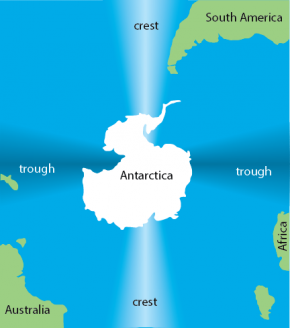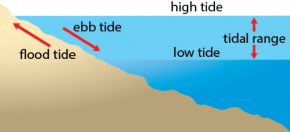Printer Friendly
NGSS Performance Expectations
NGSS PE Linking Sentence
The content and activities in this topic will work towards building an understanding of the motion of celestial objects within the solar system.
Body
Tidal Movements
┬Ā
Fig. 6.2. The ideal global tide as seen from the South Pole. At the point in time captured in the figure, high tide crests are near South America and in the South Indian ocean basin, and low tide troughs are near the southern tip of Africa and New Zealand.
Tides are predictable daily rises and falls in the surface water of the ocean and large lakes. On the coast, tides appear as the regular rise and fall of the sea surface. Tides are waves whose periods are so long that hours go by between their crests and troughs. The ideal wave of the tide wraps around the world with two crests and two troughs (Fig. 6.2). However, most of the time, and in most places, tides are much more complex.
┬Ā
Tidal changes can be described by stages (Fig. 6.3). A high tide is the stage when the tidal crest arrives at a particular location on shore, raising the local sea level. A low tide is the stage when the trough arrives, lowering the local sea level. A flood tide is a rising or incoming tide between low tide and high tide. An ebb tide is a falling or outgoing tide between high tide and low tide. The vertical distance between high tide and low tide is the tidal range.
┬Ā
Tides are predictable because they are produced by a combination of forces that are predictable. These forces are determined by the movements and positions of objects in our solar system, particularly the earth and the moon in relation to the sun. To understand tides, therefore, it is important to understand the movements of the earth and the moon relative to the sun.
┬Ā
┬Ā
Activity
Model the movements of three objects in our solar systemŌĆöthe sun, the moon, and the earthŌĆöusing your body.
┬Ā
Exploring Our Fluid Earth, a product of the Curriculum Research & Development Group (CRDG), College of Education. ® University of Hawaiįi, 2011. This document may be freely reproduced and distributed for non-profit educational purposes.










